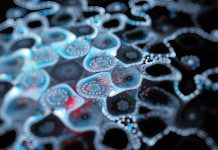Northwestern University researchers develop a molecular coating for tungsten diselenide, boosting single-photon emission purity by 87%, advancing quantum technology reliability
Northwestern University researchers have made a significant breakthrough in quantum technology with the introduction of a novel molecular coating. This coating, when applied to tungsten diselenide, has led to a remarkable 87% improvement in the spectral purity of single-photon emissions. This advancement not only addresses key challenges in quantum communication and sensing but also paves the way for more reliable and efficient quantum technologies.
Molecular coating transforms tungsten diselenide for cleaner, more reliable single-photon emission
The researchers coated an atomically thin semiconductor (tungsten diselenide) with a sheetlike organic molecule called PTCDA. The coating worked by transforming the tungsten diselenide’s behaviour, turning noisy signals into clean bursts of single photons.
The coating increased the photon’s spectral purity by 87%. Still, it shifted the colour of the photons in a controlled way and lowered the photon activation energy, all without altering the material’s underlying semiconducting properties.
This groundbreaking discovery has the potential to significantly advance the field of quantum technologies, including secure communications and ultra-precise sensors, offering a promising future for these applications.
“When there are defects, such as missing atoms, in tungsten diselenide, the material can emit single photons,” said Northwestern’s Mark C. Hersam, the study’s corresponding author. “But these points of single-photon emission are exquisitely sensitive to any contaminants from the atmosphere. Even oxygen in the air can interact with these quantum emitters, altering their ability to produce identical single photons. Any variability in the number or energy of the emitted photons limits the performance of quantum technologies. By adding a highly uniform molecular layer, we protect the single-photon emitters from unwanted contaminants.”
Enhancing quantum device performance through controlled photon emission
Quantum light sources can be likened to precise ‘photon dispensers,‘ releasing one photon at a time. The performance of these sources can be significantly impacted if multiple photons are emitted simultaneously or if the energies of the photons vary. In quantum communication, for instance, excess photons can compromise security, while in quantum sensing, inconsistent photon energies can reduce measurement accuracy.
As these technologies advance toward practical applications, researchers are working to develop photon sources that combine high brightness with exceptional purity, capable of delivering a single, identical photon on demand with complete reliability. The potential impact of this research on quantum communication and sensing is truly exciting.
In the new study, Hersam and his team focused on two-dimensional semiconductor tungsten diselenide, which can host atomic-scale defects that emit individual photons. Tungsten diselenide is atomically thin, with defects and emitters on the surface, leaving them exposed to unwanted interactions with atmospheric contaminants. This susceptibility to variability from random atmospheric species limits the reliability of tungsten diselenide for the precise operations required in quantum devices.
To overcome these challenges, Hersam’s team meticulously coated both sides of tungsten diselenide with PTCDA (perylenetetracarboxylic dianhydride), an organic molecule often found in pigments and dyes. The team deposited the molecules in a vacuum chamber one molecular layer at a time, ensuring a uniform and precise coating. The molecular coating protected the surface of tungsten diselenide and its quantum-emitting defects, without changing its core electronic structure.
“It’s a molecularly perfect coating, which presents a uniform environment for the single-photon-emitting sites,” Hersam said. “In other words, the coating protects the sensitive quantum emitters from being corrupted by atmospheric contaminants.”
The researchers protected the material from environmental disturbances, leading to the coating dramatically improving the photons’ spectral purity. Additionally, the coating caused the photons to shift to a lower energy level, which is beneficial for quantum communication devices. As a result, a more controlled, reproducible, and higher-quality single-photon output is vital for quantum technologies.
“While the coating does interact with the quantum emitting defects, it shifts the photon energy in a uniform way,” Hersam said. “In contrast, when you have a random contaminant interacting with a quantum emitter, it unpredictably shifts the energy. Uniformity is the key to getting reproducibility in quantum devices.”
“The big idea is that we want to go from individual quantum computers to quantum networks and, ultimately, a quantum internet,” Hersam said. “Quantum communication will occur using single photons. Our technology will help build single-photon sources that are stable, tunable and scalable — the essential components for making that vision a reality.”











